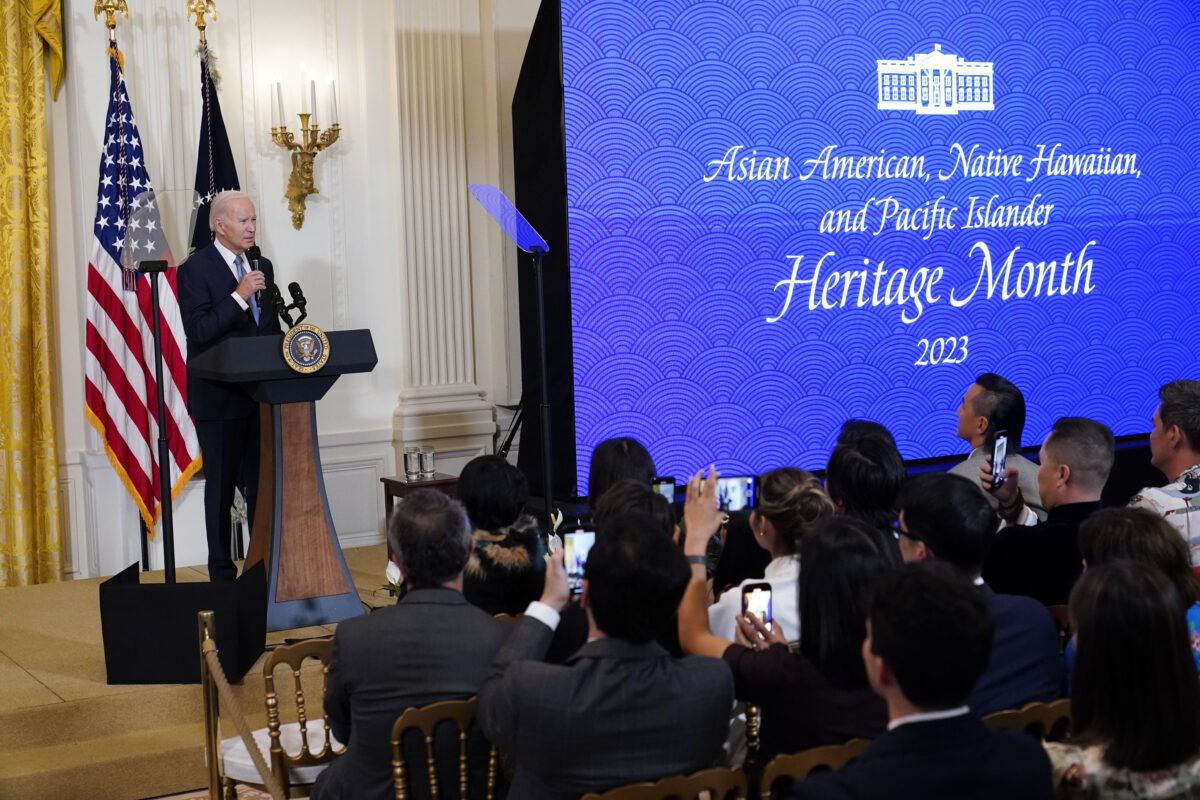Nearly half over, has it been a full AANHPI month so far?

FILE – President Joe Biden speaks in the East Room of the White House in Washington, in celebration of Asian American, Native Hawaiian, and Pacific Islander Heritage Month, May 8, 2023. (AP Photo/Susan Walsh, File)
As we approach the half-way point of our month, how does it feel? Are you empowered? Feel like a full participant in America? Or do you feel left out?
AANHPI (Asian American Native Hawaiian Pacific Islander) Heritage Month is supposed to be the antidote.
AANHPI is not a social term; it’s purely political, a Frankenstein acronym that reeks of inclusion, and yet there’s so much more of us we don’t see in the name. The Filipino is implied. It makes AANHPI more like a prompt to make sure we don’t forget the incredible potential of our large, diverse community.
We’re more than 25 million strong. Does that include the Northern Marianas? Of course. And Guam. And American Samoa.
As I like to point out, it really should include West Asians, like Arab Americans, at around 5 million strong. That would boost our numbers to around 30 million plus.
How can US policy makers ignore a coalition of 30 million people that have all of Asia as their common ground? They can’t.
Unless we don’t vote. But of course we will, especially in 2024.
The AANHPI power year
If you’re not registered to vote yet, do so. And if you don’t have voting as an automatic thing like California’s permanent vote by mail, sign up. That way, you don’t have to worry about long lines, or all the other reasons that keep people from voting. Like forgetting.
Make it a priority to fulfill the democracy part of being an American.
Then, after greeting people saying Happy Asian American Native Hawaiian Pacific Islander Heritage Month, make sure they know the significance of our coalition – as a political force of voters.
Give them the data. It’s impressive.
Around 15 million Asian Americans are projected to be eligible to vote in 2024. This is an increase of 15 percent from 2020, according to the Pew Research Center. That’s a larger projected increase than for Hispanics (12 percent) and Blacks (7 percent).
Asian Americans went from 3 percent of the electorate in 2000 to double that in a generation.
A lot of talk this year has centered so far on Black and Hispanic voters defecting from the Democrats in 2024. Hardly any talk about the Asian American vote. So, let’s start talking. Any change could be significant.
Seventy-two percent of English-speaking, single race, non-Hispanic Asian voters went for Joe Biden in 2020 vs. 28 percent who voted for Donald Trump, according to Pew.
Will we see Asian Americans continue to show up for Biden at the 72 percent level, or will that number erode? Given the state of politics in America, Biden can’t afford to lose any votes anywhere.
Considering the efforts of Biden in the past year from day one to be inclusive about Asian Americans, I have a hard time seeing our community turning from Biden. If anything, the numbers may go higher if Republican voters of our broad community (around 30 percent) understand what’s at stake and abandon Trump.
The list of White House initiatives to help Asian Americans is long. I don’t think there was even a web page for Asian Americans during the Trump White House. Just think about how Donald Trump treated his lone Asian American cabinet member Elaine Chao, and see if there’s any reason for MAGA-AANHPIs to stick with their 2020 choice.
Here are some key things about Asian American eligible voters that are also worth noting.
We’re 6 percent of the electorate, which means as a bloc, it has the potential to be a real swing vote.
When you see poll numbers at a dead heat with the margin of error at 3-5 percent, imagine Asian Americans making up the difference to provide a margin of victory.
That’s how critical our vote is.
Gender-wise, the demographic breakdown is also significant: 53 percent women, 47 percent men. Which party has women’s best interests at heart?
By age, 22 percent of us are 18-29 years old. The biggest demo is 30-49 at 36 percent. Add ages 50-64 at 23 percent and the core 30-64 working age demo is almost 60 percent of our community.
The wise owl 65-plus community is at 18 percent. We are younger community than we think.
The majority of us are also naturalized citizens, 56 percent, vs. US born at 44 percent. Asian America was created by the 1965 Immigration Act. For me this is always where I see some of the biggest fissures within our community. Who was pushing for affirmative action and who was against? Naturalized citizens, immigrants generally led the fight against affirmative action. It remains a flash point. Might it also define a new dividing line between Asian American red and blue?
One other distinction about the Asian American voter is that we do like education – 74 percent of us fall in the spectrum of having two-year degrees, some college, bachelor’s or some post-graduate degrees. Compare that to all US adults at just 64 percent.
So this month, let’s do the fun cultural things; share our stories, our food, all the Asian parts. Celebrate us all. But don’t forget to ponder the inclusiveness of the term AANHPI, our political umbrella in this critical 2024 year.
The umbrella is our tool. We can stay dry and weather all the storms, but only if we stand together, recognize our electoral strength, and vote our common interests.
Emil Guillermo is a journalist and commentator. He has worked in Hawaii, California, Texas and Washington, DC, where he was the first Filipino to host a national news program while at NPR’s “All Things Considered.” He writes a column for Inquirer.net’s US channel. Contact him at www.amok.com.

